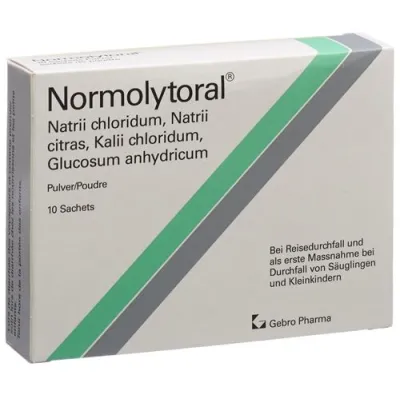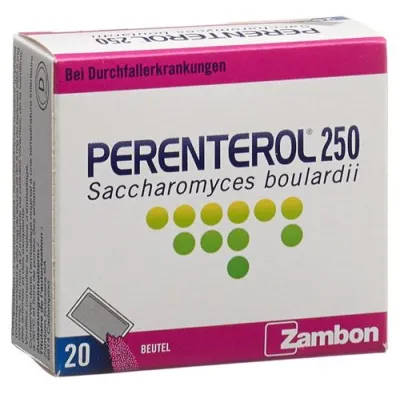travelers diarrhea
(1 Pages)
Normolytoral powder bag 10 pcs
Normolytoral is used to compensate for salt and fluid losses and is used for travelers' diarrhea and as the first measure for diarrhea in infants and small children. Swissmedic-approved patient informationNormolytoral®Gebro Pharma AGAMZVWhat is normolytoral and when is it used?Normolytoral is used to compensate for salt and fluid losses and is used for travelers' diarrhea and as the first measure for diarrhea in infants and small children. What should be considered?Notes for diabetics: 1 Normolytoral sachet corresponds to 0.3 BE. When must Normolytoral not be used?Normolytoral must not be taken if you have impaired kidney function, uncontrollable vomiting, severe clouding of consciousness, shock, lack of urination, a certain metabolic disorder (monosaccharide malabsorption). When is caution required when taking Normolytoral?In the case of diarrhea in infants and children under the age of 3 years, a doctor must be consulted. If you suffer from cardiac insufficiency, high blood pressure or diabetes, the preparation may only be taken under medical supervision. Any diarrhea can be a sign of a serious illness. In particular, if the diarrhea is accompanied by fever and if blood is found in the stool, a doctor should be consulted. Inform your doctor, pharmacist or druggist if you have –suffer from other diseases, –have allergies or –Take other medicines (including those you bought yourself!) or use them externally. Can Normolytoral be taken during pregnancy or breastfeeding?Based on previous experience, there is no known risk for the child when used as intended. However, systematic scientific investigations have never been carried out. As a precaution, you should avoid taking medicines during pregnancy and breastfeeding or ask your doctor, pharmacist or druggist for advice. How do you use Normolytoral?The entire content of one sachet of Normolytoral is dissolved in 200 ml (approx. 1 1/2 teacups) of drinking water or unsweetened tea, at room temperature or cooled underneath. Please keep to the mixing ratio exactly. Do not take undiluted! General recommendations (diarrhea without significant weight loss): Unless otherwise prescribed by the doctor, the amount to drink depends on the need (= thirst), but the maximum amounts listed in the following table should not be exceeded. Maximum quantity in 24 hours: Infants(up to 1 year)Children from 2. up to the age of 5Children over 5. J., adolescentsand adultsbody weightml/24 hours Body weightml/24 hrsBody weightml/24 hrs 3 kg22510 kg600 td>20 kg8004 kg 30012 kg72025 kg10005 kg37514 kg840 30 kg12006 kg45016 kg 96040 kg16007 kg52518 kg108050 kg2000 8 kg60020 kg1200 td>60 kg24009 kg 67522 kg132070 kg280010 kg75080 kg320090 kg3600 If the water and salt losses have already led to a significant weight loss (of about 5-8%): In a first intensive treatment phase of 4-6 hours, approx. 40-50 ml normolytoral solution/kg body weight should be taken regardless of age (please consult a doctor in these severe cases). Then proceed as with the general recommendations, i. the amount you drink depends on what you need (= thirst). The maximum values given in the table apply for the 24 hours following the intensive phase. With the decrease in diarrhea and the hardening of the stools, the normolytoral intake should be reduced. Treatment with normolytoral usually lasts 24 hours. In the event of vomiting, normolytoral is given at short intervals by the spoonful or in sips and, if possible, chilled. Breastfed infants should also be breastfed during treatment with normolytoral. Otherwise, you should take a break from eating at least until the diarrhea subsides (calories are supplied by glucose and citrate in normolytoral). In addition to the maximum drinking quantities specified above, unsweetened liquids (tea, thin fruit juices; sweeten with artificial sweeteners if necessary) are permitted, especially in the event of a high fever or hot weather. After treatment with normolytoral, a transitional diet is advisable: for infants, for example, rice gruel or a "carrot soup according to Moro" (100 g early carrots - commercial preparation for small children - in 100 ml boiled water, lightly salted), grated for older children and adults Apples, bouillon, mashed potatoes, later lean meat. Stick to the dosage given in the package leaflet or as prescribed by your doctor. If you think the medicine is too weak or too strong, talk to your doctor, pharmacist or druggist. What side effects can normolytoral have?No side effects have so far been observed for normolytoral when the recommended dosage is observed. If you do notice any side effects, you should inform your doctor, pharmacist or druggist. What else needs to be considered?Keep out of the reach of children. Store at room temperature (15-25°C) away from moisture. A short-term deviation from these storage instructions (e.g. when taking along on trips) is possible. The medicinal product may only be used up to the date marked «EXP» on the container. Your doctor, pharmacist or druggist can provide you with further information. These people have the detailed information for specialists. What does Normolytoral contain?1 sachet of 5.4 g contains: Active ingredients: 4 g anhydrous glucose, 0.35 g sodium chloride, 0.59 g sodium citrate, 0.3 g potassium chloride. Excipients: saccharin, vanillin, flavorings. The ready-to-drink solution (after dissolving the contents of one sachet in 200 ml drinking water) contains: sodium 60 mmol/l, potassium 20 mmol/l, citrate 10 mmol/l, chloride 50 mmol/l. Approval number43916 (Swissmedic) Where can you get normolytoral? What packs are available?In pharmacies and drugstores without a doctor's prescription. Packs of 10 sachets. Authorization holderGebro Pharma AG, 4410 LiestalThis leaflet was last checked by the drug authority (Swissmedic) in October 2005. ..
26.46 USD
Perenterol powder 250 mg bag 20 pcs
What is Perenterol 250 and when is it used? Perenterol 250 is an antidiarrheal and contains a yeast fungus (Saccharomyces boulardii) as the active substance. It is used to treat diarrheal diseases such as traveler's diarrhea and, if prescribed by a doctor, for the prevention and treatment of antibiotic-related diarrhea or diarrhea caused by tube feeding; in conjunction with other measures, it allows the restoration of the intestinal flora and the alleviation of diarrhea.Perenterol 250 regulates and normalizes intestinal activity.The yeast Saccharomyces boulardii is resistant to antibiotics and acts in the intestinal interior in a living form. It is not absorbed by the body.Various studies have shown an inhibiting effect on the development of various harmful bacteria and Candida albicans.What should be considered?In the case of diarrhea, the patient (especially children and the elderly) should drink enough fluids. If the illness lasts longer than 2-3 days, the doctor should be consulted. In infants, diarrhea can quickly become dangerous after just one day due to the loss of fluid and salt. You should therefore consult your doctor in good time.When should Perenterol 250 not be used?In the event of hypersensitivity to the preparation. Yeast allergy, especially against Saccharomyces boulardii.Perenterol 250 must not be used in patients with severe immune deficiency (e.g. HIV infections, organ transplants, leukemia, malignant advanced tumors, radiation, chemotherapy, long-term high-dose cortisone treatment).Patients with a central venous catheter (e.g. Port-A-cath) may use Perenterol 250 because of infection Do not use with Saccharomyces boulardii. When is caution required when taking Perenterol 250? Since Perenterol 250 consists of living cells, the preparation must not be mixed with a liquid or food that is too hot (over 50 °C), ice-cold or alcoholic. Furthermore, the yeasts contained in Perenterol 250 are sensitive to antifungal drugs ( antifungals). If your doctor has prescribed such medicines for you, you must refrain from taking Perenterol 250 because its active substance will then be destroyed.Inform your doctor, pharmacist or druggist if yousuffer from other diseases,have allergies orother medicines (including those you bought yourself! )!Can Perenterol 250 be taken during pregnancy or while breastfeeding?There are no objections to using Perenterol 250 during pregnancy or while breastfeeding.How do you use Perenterol 250?The preparation is taken orally.Initial dosage: on the 1st day 2 sachets or 2 capsules (1st in the morning and 1 in the evening).Further dosage: on the following days: 1 sachet or 1 capsule daily until no more symptoms of the disease appear.On medical advice, the initial dosage (2 sachets or 2 capsules daily) can be continued or increased over several days if necessary.In case of vomiting within 1 hour after administration of the drug, the intake must be repeated.Perenterol 250 can be used by infants, children and adults be administered in the same dosage.ApplicationPouch: mix the contents of the sachet with liquid or mushy food, then swallow. For infants: sprinkle the contents of the sachet over the pap or add to the bottle. Pay attentione make sure that the food is not too hot (not over 50 °C).Capsules: swallow the capsule with some liquid.Perenterol 250 can be taken at any time of the day. If you want to achieve a rapid onset of action, you can take the preparation before meals. You can also take Perenterol 250 together with an antibiotic at any time, but not together with an antifungal. Stick to the dosage given in this leaflet or prescribed by the doctor. If you think the drug is too weak or too strong, talk to your doctor, pharmacist or druggist.What side effects can Perenterol 250 have?In rare cases, flatulence occurs after taking Perenterol 250 and in very rare cases constipation. Very rarely, allergic skin reactions such as itching, skin rashes or hives, shortness of breath, anaphylactic reactions and anaphylactic shock can occur.In very rare cases, yeast fungi have penetrated the blood (fungaemia) and isolated cases of severe blood infections (sepsis), which can also include fever, in seriously ill or immunocompromised patients or in patients with central venous catheters.If you notice any side effects, please contact us to your doctor, pharmacist or druggist. This also applies in particular to side effects that are not listed in this leaflet.What else needs to be taken into account?The medicinal product may only be used up to the date marked «EXP» on the container.Storage instructionsDo not store above 30 °C and keep out of the reach of children.Further informationYour doctor, pharmacist or druggist can provide you with further information Your doctor, pharmacist or druggist. These people have the detailed technical information. What does Perenterol 250 contain? Active ingredients 250 mg Saccharomyces boulardii lyophilized (250 mg yeast), corresponding to at least 2 billion viable cells. Excipients 1 sachet contains: 32.5 mg lactose, vanillin, flavorings and additives . 1 capsule contains: 32.5 mg lactose and excipients. Approval number 47572, 47571 (Swissmedic). Where can you get Perenterol 250? Which packs are available? In pharmacies and drugstores, without a doctor's prescription. Packs of 10 and 20 sachets and packs of 6, 10 and 20 capsules. Authorization holder Zambon Schweiz AG, 6814 Cadempino This package leaflet was last published in February 2021 by the drug authority (Swissmedic ) checked...
49.46 USD
(1 Pages)


